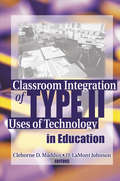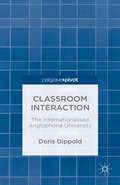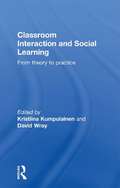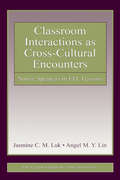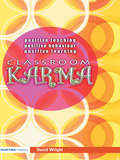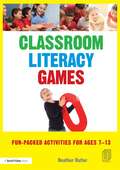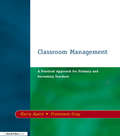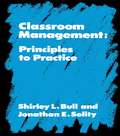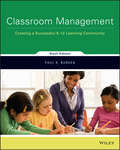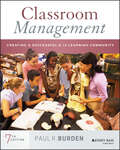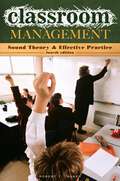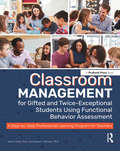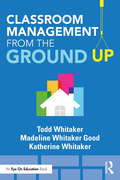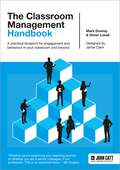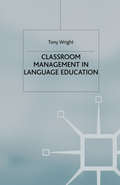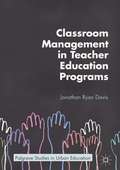- Table View
- List View
Classroom Integration of Type II Uses of Technology in Education
by Cleborne D MadduxDevelop new strategies for using computers in the classroomEducators have talked about using information technology to improve teaching since the beginning of the modern computer movement but true integration remains an elusive goal-for most. Classroom Integration of Type II Uses of Technology in Education finds teachers who have managed to take advantage of the sophistication, power, and affordability of today&’s technology to develop new and better strategies for learning, despite the absence of an effective institutional infrastructure. This unique book reviews effective Type II teaching applications and software used at all educational levels, including Lego/Logo technologies, idea technologies, graphics software, laptop computers, and handheld computers. Information technology in schools has failed to fulfill its considerable potential because without a widespread instructional support system, computers are generally poorly used and not integrated meaningfully into classroom activities. But some educators have still been able to implement Type II applications of information technology in their educational settings. Classroom Integration of Type II Uses of Technology in Education looks at their innovative methods of using computers to bring about more effective teaching-and learning.Classroom Integration of Type II Uses of Technology in Education examines: computer activities of grade 1-5 students using Lego/Logo technologies using Kid-Pix graphics software for creative activities the Technology Integration Assessment Instrument (TIAI) gender disparity in computer-oriented problem solving a three-tiered, idea-technology classification system pre-service teacher preparation assistive technology definitions, legislation, and implementation issues lesson plans and document techniques for laptop computers an action/instructional model for using handheld wireless computers in the classroom Classroom Integration of Type II Uses of Technology in Education is an invaluable resource for academics working in information technology and education, and for K-12 teachers and administrators at all levels.
Classroom Integration of Type II Uses of Technology in Education
by Cleborne D MadduxDevelop new strategies for using computers in the classroomEducators have talked about using information technology to improve teaching since the beginning of the modern computer movement but true integration remains an elusive goal-for most. Classroom Integration of Type II Uses of Technology in Education finds teachers who have managed to take advantage of the sophistication, power, and affordability of today&’s technology to develop new and better strategies for learning, despite the absence of an effective institutional infrastructure. This unique book reviews effective Type II teaching applications and software used at all educational levels, including Lego/Logo technologies, idea technologies, graphics software, laptop computers, and handheld computers. Information technology in schools has failed to fulfill its considerable potential because without a widespread instructional support system, computers are generally poorly used and not integrated meaningfully into classroom activities. But some educators have still been able to implement Type II applications of information technology in their educational settings. Classroom Integration of Type II Uses of Technology in Education looks at their innovative methods of using computers to bring about more effective teaching-and learning.Classroom Integration of Type II Uses of Technology in Education examines: computer activities of grade 1-5 students using Lego/Logo technologies using Kid-Pix graphics software for creative activities the Technology Integration Assessment Instrument (TIAI) gender disparity in computer-oriented problem solving a three-tiered, idea-technology classification system pre-service teacher preparation assistive technology definitions, legislation, and implementation issues lesson plans and document techniques for laptop computers an action/instructional model for using handheld wireless computers in the classroom Classroom Integration of Type II Uses of Technology in Education is an invaluable resource for academics working in information technology and education, and for K-12 teachers and administrators at all levels.
Classroom Interaction: The Internationalised Anglophone University
by Doris DippoldInternationalisation has had a forceful impact on universities across the Anglophone world. This book reviews what we know about interaction in the Anglophone university classroom, describes the challenges students and tutors face, and illustrates how they can overcome these challenges by drawing on their own experiences and practices.
Classroom Interactions and Social Learning: From Theory to Practice
by Kristiina Kumpulainen David WrayToday's classroom presents a wealth of opportunities for social interaction amongst pupils, leading to increased interest in teachers and researchers into the social nature of learning.While classroom interaction can be a valuable tool for learning, it does not necessarily lead to useful learning experiences. Through case studies, this book highlights the use of new analytical methodologies for studying the content and patterns of children's interactions and how these contribute to their construction of knowledge.Classroom Interaction and Social Learning will be of interest to students and in service teachers and researchers concerned with classroom discourse and learning.
Classroom Interactions and Social Learning: From Theory to Practice
by Kristiina Kumpulainen David WrayToday's classroom presents a wealth of opportunities for social interaction amongst pupils, leading to increased interest in teachers and researchers into the social nature of learning.While classroom interaction can be a valuable tool for learning, it does not necessarily lead to useful learning experiences. Through case studies, this book highlights the use of new analytical methodologies for studying the content and patterns of children's interactions and how these contribute to their construction of knowledge.Classroom Interaction and Social Learning will be of interest to students and in service teachers and researchers concerned with classroom discourse and learning.
Classroom Interactions as Cross-Cultural Encounters: Native Speakers in EFL Lessons (ESL & Applied Linguistics Professional Series)
by Jasmine C. Luk Angel M. LinClassroom Interactions as Cross-Cultural Encounters is about native English speakers teaching English as a global language in non-English speaking countries. Through analysis of naturally occurring dialogic encounters, the authors examine the multifaceted ways in which teachers and students utilize diverse communicative resources to construct, display, and negotiate their identities as teachers, learners, and language users, with different pedagogic, institutional, social, and political implications. A range of issues in applied linguistics is addressed, including linguistic imperialism, post-colonial theories, micropolitics of classroom interaction, language and identity, and bilingual classroom practices. Intended to help TESOL professionals of different cultural backgrounds, working in different sociocultural contexts, to critically understand how non-assimilationist, dialogic intercultultural communication with students can be achieved and built on for mutual cultural and linguistic enrichment and empowerment, this book:*emphasizes the sociocultural meanings and micropolitics of classroom interactions that reveal the complex realities of power and identity negotiations in cross-cultural interactions in ELT (English Language Teaching) classroom contexts;*revisits and reconstitutes the notion of native-speakerness and repositions the roles of native and non-native English teachers in the TESOL profession in the contexts of decolonization and globalization; *highlights the need to mobilize intercultural communicative resources for global communication;*addresses two major concerns of EFL (English as a Foreign Language) classroom researchers and teachers: student resistance and learning motivation; and*examines and analyzes the changing ideologies (both explicit and implicit) of teachers and students about English learning in the context of a post-colonial society, and how these ideologies are being enacted, reproduced, but also sometimes contested in EFL classroom interactions. Each chapter includes Questions for Reflection and Discussion to promote critical thinking and understanding of the issues discussed. Tuning-In discussion questions are provided in the three chapters on classroom data analysis to activate readers interpretive schemas before they examine the actual classroom episodes. The data are from an ethnographic study in post-colonial Hong Kong secondary schools involving four native English-speaker teachers and two bilingual Cantonese-English speaking teachers engaged in intercultural classroom dialogues with their Cantonese Hong Kong students. The rich, naturally occurring classroom data and in-depth analyses provide useful pedagogical materials for courses in EFL teacher education programs on classroom discourse analysis from sociocultural perspectives.
Classroom Interactions as Cross-Cultural Encounters: Native Speakers in EFL Lessons (ESL & Applied Linguistics Professional Series)
by Jasmine C. Luk Angel M. LinClassroom Interactions as Cross-Cultural Encounters is about native English speakers teaching English as a global language in non-English speaking countries. Through analysis of naturally occurring dialogic encounters, the authors examine the multifaceted ways in which teachers and students utilize diverse communicative resources to construct, display, and negotiate their identities as teachers, learners, and language users, with different pedagogic, institutional, social, and political implications. A range of issues in applied linguistics is addressed, including linguistic imperialism, post-colonial theories, micropolitics of classroom interaction, language and identity, and bilingual classroom practices. Intended to help TESOL professionals of different cultural backgrounds, working in different sociocultural contexts, to critically understand how non-assimilationist, dialogic intercultultural communication with students can be achieved and built on for mutual cultural and linguistic enrichment and empowerment, this book:*emphasizes the sociocultural meanings and micropolitics of classroom interactions that reveal the complex realities of power and identity negotiations in cross-cultural interactions in ELT (English Language Teaching) classroom contexts;*revisits and reconstitutes the notion of native-speakerness and repositions the roles of native and non-native English teachers in the TESOL profession in the contexts of decolonization and globalization; *highlights the need to mobilize intercultural communicative resources for global communication;*addresses two major concerns of EFL (English as a Foreign Language) classroom researchers and teachers: student resistance and learning motivation; and*examines and analyzes the changing ideologies (both explicit and implicit) of teachers and students about English learning in the context of a post-colonial society, and how these ideologies are being enacted, reproduced, but also sometimes contested in EFL classroom interactions. Each chapter includes Questions for Reflection and Discussion to promote critical thinking and understanding of the issues discussed. Tuning-In discussion questions are provided in the three chapters on classroom data analysis to activate readers interpretive schemas before they examine the actual classroom episodes. The data are from an ethnographic study in post-colonial Hong Kong secondary schools involving four native English-speaker teachers and two bilingual Cantonese-English speaking teachers engaged in intercultural classroom dialogues with their Cantonese Hong Kong students. The rich, naturally occurring classroom data and in-depth analyses provide useful pedagogical materials for courses in EFL teacher education programs on classroom discourse analysis from sociocultural perspectives.
Classroom Karma: Positive Teaching, Positive Behaviour, Positive Learning
by David WrightA positive and calm classroom environment enriches the teaching and learning experience for teachers and children alike. Using his invaluable experience working in pupil referral units and as a head teacher, David Wright shows how the ideal primary classroom environment can be achieved through many useful practical ideas and suggestions. Backed by up-to-date research on how we learn and how best to teach, the clear and concise chapters cover broad teaching skills including: how to create a positive learning environment where pupils feel valued, prepared to leave their 'comfort zone', and willing to ask questions understanding what effects certain aspects of your behaviour can have on children behaviour management strategies that allow the children to take responsibility for their actions making the most of colleagues, parents and your community to provide memorable learning experiences. Written by a teacher for teachers, Classroom Karma is essential reading for all those looking to establish a successful learning environment where pupils feel valued and motivated in the primary classroom and beyond.
Classroom Karma: Positive Teaching, Positive Behaviour, Positive Learning
by David WrightA positive and calm classroom environment enriches the teaching and learning experience for teachers and children alike. Using his invaluable experience working in pupil referral units and as a head teacher, David Wright shows how the ideal primary classroom environment can be achieved through many useful practical ideas and suggestions. Backed by up-to-date research on how we learn and how best to teach, the clear and concise chapters cover broad teaching skills including: how to create a positive learning environment where pupils feel valued, prepared to leave their 'comfort zone', and willing to ask questions understanding what effects certain aspects of your behaviour can have on children behaviour management strategies that allow the children to take responsibility for their actions making the most of colleagues, parents and your community to provide memorable learning experiences. Written by a teacher for teachers, Classroom Karma is essential reading for all those looking to establish a successful learning environment where pupils feel valued and motivated in the primary classroom and beyond.
Classroom Literacy Games: Fun-packed activities for ages 7-13
by Heather ButlerChildren enjoyed it so much they didn’t realise they were being worked so hard.Jo Miles, Learning Support Assistant at Manor Farm Community Junior School, Hazlemere, Buckinghamshire Great speaking and listening activity-setting-up ideas for the Big Write. The games extended the children’s vocabulary. Purposeful learning – love it!Liz Pilgrim, Senior Teacher at Manor Farm Community Junior School, Hazlemere, Buckinghamshire Educational games played in groups or pairs help develop key language and social skills. Based on a range of material to extend vocabulary, punctuation and cross-curricular creativity, Classroom Literacy Games contains original games with suggestions of how to develop writing tasks after playing them. Each game is differentiated four ways and aims to teach literacy (including vocabularly, connectives, openers and punctuation) to higher KS1, KS2 and lower KS3. Printed with dyslexia-friendly fonts, these cross-curricular games are suitable for mixed-ability classrooms, small groups or one-to-one teaching situations. As either photocopiable resources to be used in the classroom or as homework activities, these games will create situations to generate creative writing and for the children to create their own games. They can also be used for EAL, guided reading and weekly Big Write exercises. With minimal preparation time required and a vast number of games, these user-friendly, pick-up-and-go activities will be of interest to any practicing primary and lower KS3 teacher.
Classroom Literacy Games: Fun-packed activities for ages 7-13
by Heather ButlerChildren enjoyed it so much they didn’t realise they were being worked so hard.Jo Miles, Learning Support Assistant at Manor Farm Community Junior School, Hazlemere, Buckinghamshire Great speaking and listening activity-setting-up ideas for the Big Write. The games extended the children’s vocabulary. Purposeful learning – love it!Liz Pilgrim, Senior Teacher at Manor Farm Community Junior School, Hazlemere, Buckinghamshire Educational games played in groups or pairs help develop key language and social skills. Based on a range of material to extend vocabulary, punctuation and cross-curricular creativity, Classroom Literacy Games contains original games with suggestions of how to develop writing tasks after playing them. Each game is differentiated four ways and aims to teach literacy (including vocabularly, connectives, openers and punctuation) to higher KS1, KS2 and lower KS3. Printed with dyslexia-friendly fonts, these cross-curricular games are suitable for mixed-ability classrooms, small groups or one-to-one teaching situations. As either photocopiable resources to be used in the classroom or as homework activities, these games will create situations to generate creative writing and for the children to create their own games. They can also be used for EAL, guided reading and weekly Big Write exercises. With minimal preparation time required and a vast number of games, these user-friendly, pick-up-and-go activities will be of interest to any practicing primary and lower KS3 teacher.
Classroom Management: A Practical Approach for Primary and Secondary Teachers
by Harry Ayers Francesca GrayFirst Published in 1998. Routledge is an imprint of Taylor & Francis, an informa company.
Classroom Management: A Practical Approach for Primary and Secondary Teachers
by Harry Ayers Francesca GrayFirst Published in 1998. Routledge is an imprint of Taylor & Francis, an informa company.
Classroom Management: Principles to Practice
by Shirley Bull Phillip Feldman Jonathan SolityHow to manage a class is probably the major worry of all teachers in training and young teachers new to the job. This book shows how psychological principles, strategies and tools can be applied to improve classroom practice.
Classroom Management: Principles to Practice
by Shirley Bull Phillip Feldman Jonathan SolityHow to manage a class is probably the major worry of all teachers in training and young teachers new to the job. This book shows how psychological principles, strategies and tools can be applied to improve classroom practice.
Classroom Management: Creating a Successful K-12 Learning Community
by Paul BurdenA practical guide to what can be accomplished utilizing the technical aspects of Classroom Management, this invaluable resource will not only help educators learn how to build positive classroom communities, but also outline methods for involving students in the creation of their learning environment. The Sixth Edition has been updated to include a new chapter on communication skills for teaching, incorporated classroom case studies in each chapter, and includes updates using the latest management research in several chapters.
Classroom Management: Sound Theory and Effective Practice
by Robert T. TauberEducators need a balance between discipline theory and its practice in the classroom. This is especially important in today's educational climate, with its increased demands for teacher accountability. Tauber has designed this book for both those who are new to teaching and those who are already seasoned teachers but who have had little, if any, coursework in discipline. This book presents several sound frameworks that readers can use to evaluate six tried-and-true discipline models. Teachers need to select, learn, and implement a discipline model that best reflects how they feel students should be treated. Tauber explores a number of topics, some controversial, all quite relevant, concerning how teachers can prevent, as well as handle, problem behaviors. A chapter describing A through Z discipline suggestions can be immediately put into use.
Classroom Management for Gifted and Twice-Exceptional Students Using Functional Behavior Assessment: A Step-by-Step Professional Learning Program for Teachers
by Yarah Farah Susan K. JohnsenClassroom Management for Gifted and Twice-Exceptional Students Using Functional Behavior Assessment assists educators in understanding how to identify and target behaviors that influence the success of students and daily classroom instruction. Each module:Provides case studies with examples of the concepts being taught.Includes presentations, interactive graphic organizers, and small-group problem-solving activities.Offers self-assessments and resources for developing interventions.May be used within a university course, a series of workshops, or professional teacher learning communities.Uses functional behavior assessment (FBA), a successful research-based approach to behavioral interventions.Using this book, teachers can learn to manage student behavior and implement differentiation in the classroom.
Classroom Management for Gifted and Twice-Exceptional Students Using Functional Behavior Assessment: A Step-by-Step Professional Learning Program for Teachers
by Yarah Farah Susan K. JohnsenClassroom Management for Gifted and Twice-Exceptional Students Using Functional Behavior Assessment assists educators in understanding how to identify and target behaviors that influence the success of students and daily classroom instruction. Each module:Provides case studies with examples of the concepts being taught.Includes presentations, interactive graphic organizers, and small-group problem-solving activities.Offers self-assessments and resources for developing interventions.May be used within a university course, a series of workshops, or professional teacher learning communities.Uses functional behavior assessment (FBA), a successful research-based approach to behavioral interventions.Using this book, teachers can learn to manage student behavior and implement differentiation in the classroom.
Classroom Management From the Ground Up
by Todd Whitaker Madeline Whitaker Good Katherine WhitakerClassroom management can make or break your teaching. But as educators know, there is no one-fits-all solution for every classroom. That is why bestselling authors Todd Whitaker, Madeline Whitaker Good, and Katherine Whitaker came together to write this book. They created a guide combining sound research with practical wisdom so educators could have a classroom management resource written by teachers for teachers. From this book, you’ll gain effective strategies for designing and improving your classroom management from the ground up. You’ll learn how the three core aspects of classroom management (relationships, high and clear expectations, and consistency) can be used to build and maintain an effectively-run classroom. You’ll also find out how to tweak minor issues and reset major challenges when things don’t go as planned. Each chapter covers a core aspect of classroom management and includes a foundational understanding of the concept, powerful stories and examples, how-to applications, and tips on tweaking as problems arise. In addition, each chapter features a "What You Can Do Tomorrow" section--strategies you can implement immediately. Whether you are a new or experienced teacher, this book will empower you to identify what is going well, adjust what needs to be changed, and feel more prepared for the unexpected.
Classroom Management From the Ground Up
by Todd Whitaker Madeline Whitaker Good Katherine WhitakerClassroom management can make or break your teaching. But as educators know, there is no one-fits-all solution for every classroom. That is why bestselling authors Todd Whitaker, Madeline Whitaker Good, and Katherine Whitaker came together to write this book. They created a guide combining sound research with practical wisdom so educators could have a classroom management resource written by teachers for teachers. From this book, you’ll gain effective strategies for designing and improving your classroom management from the ground up. You’ll learn how the three core aspects of classroom management (relationships, high and clear expectations, and consistency) can be used to build and maintain an effectively-run classroom. You’ll also find out how to tweak minor issues and reset major challenges when things don’t go as planned. Each chapter covers a core aspect of classroom management and includes a foundational understanding of the concept, powerful stories and examples, how-to applications, and tips on tweaking as problems arise. In addition, each chapter features a "What You Can Do Tomorrow" section--strategies you can implement immediately. Whether you are a new or experienced teacher, this book will empower you to identify what is going well, adjust what needs to be changed, and feel more prepared for the unexpected.
The Classroom Management Handbook: A practical blueprint for engagement and behaviour in your classroom and beyond
by Oliver Lovell Dr. Mark DowleyPerhaps the biggest factor influencing teacher wellbeing and student learning is whether students are calm, focussed, and attentive in the classroom. Despite this, most teachers feel that their teacher training allocated far too little time to the fundamental principles and practical strategies that form the foundation of effective classroom management. In this book, Mark Dowley and Ollie Lovell address this shortfall by revealing 10 principles and 18 routines that will set you up for classroom management success. The Classroom Management Handbook, is the most concise, scaffolded, and unapologetically practical guide to classroom management available.
Classroom Management in Language Education (Research and Practice in Applied Linguistics)
by T. WrightA book that develops an understanding of practices at the very centre of language education - the classroom. It is written for postgraduate students in Applied Linguistics and Education, and practitioners, whether in TESOL or other language teaching, In Part 1 the author explores key concepts in unpacking the complexity of classroom life. In Part 2 existing research and practice are examined through a series of research case studies. Part 3 provides a template for research activity and suggestions for projects and methodologies, and Part 4 collects resources for readers keen to follow up the themes developed in the book.
Classroom Management in Teacher Education Programs
by Jonathan Ryan DavisThis book investigates the impact of integrating culturally relevant and pedagogically dynamic classroom management strategies into the curriculum of an urban secondary education pre-service methods course. The book begins by framing the problem of integrating classroom management into the lives of those learning to teach impact. It then examines multiple case studies of students from the study’s control cohort who did not have classroom management coursework in their methods course. After breaking down the challenges encountered by the control students, the book offers DCMA as a framework from which teacher educators might create an integrative methods course. The book then analyzes students from the study’s experimental cohort and how they benefited from such an integrative course throughout their teacher preparation and into their first year of teaching.
